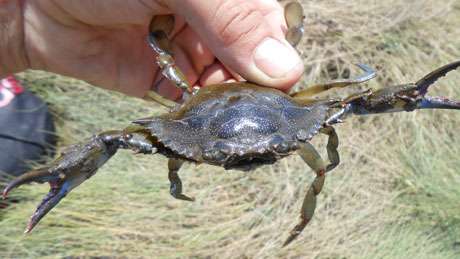Is the tasty blue crab's natural range creeping north?

David Johnson was standing in a salt marsh tidal creek north of Boston, Mass., when he scooped up a blue crab, Callinectes sapidus, 80 miles north of its native range. The northern migration of this commercially important species, Johnson says, could be yet another sign of climate change. Then a scientist at the Marine Biological Laboratory (MBL) Ecosystems Center, Johnson recently published his observations in the Journal of Crustacean Biology.
The historic northern limit of this species of crab (also called Atlantic blue or Chesapeake blue) is Cape Cod, Mass. They typically weren't found in the Gulf of Maine due to its cold Canadian waters. From 2012 to 2014, however, scientists and resource managers observed blue crabs as far north as northern Maine and Nova Scotia, Canada. Johnson hypothesizes that warmer ocean temperatures in 2012 and 2013, which were 1.3°C higher than the previous decade's average, allowed the crabs to move north.
"Climate change is lowering the thermal barriers that kept species from moving toward the poles," he says. "Climate change presents a challenge not only for ecologists, but for fisheries managers as commercially important species shift their ranges in response to warming oceans."
Ephemeral populations of blue crabs have been documented previously in the Gulf of Maine. Johnson notes that in the 1950s blue crabs were observed in the gulf during a time of warmer waters. But once the waters returned to average temperatures, the crabs disappeared.
"It's too early to determine if the current blue crab population in the Gulf of Maine is permanent or ephemeral," Johnson says. "However, models predict an increasing warming of the world's oceans and recent observations of blue crabs may be a crystal ball into the future ecology of the Gulf of Maine."
Other researchers have documented the northern movement of other commercially important species in northeastern United States such as lobsters, hake and flounder. Johnson's work, however, is the first to document the movement of a commercially important species into the Gulf of Maine.
This is the second crustacean Johnson has documented as expanding into the Gulf of Maine. In 2014 he published his findings on the rapid expansion of the fiddler crab, Uca pugnax, into the gulf. "As the world's oceans continue to warm, we will continue to see climate-driven range expansions," he predicts.
More information: Johnson DS (2015) The savory swimmer swims north: a northern range extension of the blue crab Callinectes sapidus? J. Crustacean Biology 35: 105-110.
Provided by Marine Biological Laboratory


















